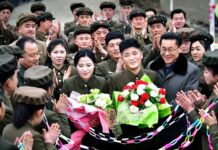December 17, 2021 marks ten years of Kim Jong-un rule. The Seoul-based Transitional Justice Working Group (TJWG) analyses satellite imagery and interviews with North Korean escapees to examine how state killing practices have shifted in the Democratic People’s Republic of Korea (North Korea) under the young leader. North Korea, in response to international criticism, has changed its killing practices, clamping down on potential information leakages by selecting execution sites that are easier to control. The report presents in-depth analysis of identified killing sites in Hyesan City before and after Kim Jong-un took power.
The new report, “Mapping Killings under Kim Jong-un: North Korea’s Response to International Pressure,” is based on 6 years of research and 683 escapee interviews documenting and mapping three types of locations connected to human rights violations:
- State-sanctioned killing sites;
- Sites where the dead are disposed of by the state;
- Official locations which may contain documents or other evidence related to these events.
Geographical mapping of sites connected to human rights abuses provides important information that are often not visible in individual interviewee testimonies. The project uses satellite imagery during interviews with North Korean escapees to geolocate sites and applies Geographic Information Systems (GIS) technology throughout the research process.
Based on interviews with 683 North Korean escapees, the Mapping Project documented
- 442 testimonies of state-sanctioned killings.
- 30 testimonies of body disposal sites, including burial and cremation sites.
In the Kim Jong-un era
- the Mapping Project documented 27 testimonies of state-sanctioned killing sites, of which 23 were public executions. Of the 23 executions, 21 were by firing squad and 2 were by hanging.
- public executions took place in open spaces and fields, airfields, river banks, and hills/mountains.
- the most commonly cited offenses announced at public executions included (in descending order of frequency): watching or distributing South Korean videos (7 instances), drug-related crimes (5), prostitution (5), human trafficking (4), murder or attempted murder (3), and “obscene acts” (3).
- interviewees reported that inhumane treatment of the accused before execution—used as a warning to the public—has persisted under Kim Jong-un.
- in some cases pardons were issued to propagandize the benevolence of Kim Jong-un.
In Hyesan, during the Kim Jong-un era
- the Mapping Project documented 10 testimonies of state-sanctioned killings.
- public executions occurred in places such as Hyesan Airfield or in the surrounding hills/mountains and open spaces/fields away from the border and central area of the city.
- the research recorded 26 public trials. Of these, there were four documented cases in which the authorities issued a death penalty to the accused, but execution did not take place at the trial.
- interviewees reported students being systematically mobilized to attend public trials.
- interviewees reported that the number of public executions seems to be declining, but secret killings continue to take place.
The report’s lead author, Ahyeong Park, said:
“Our findings suggest that the Kim Jong-un regime is paying more attention to human rights issues as a response to increased international scrutiny over the gravity of the situation in North Korea. This does not mean the human rights situation in North Korea is improving; state-led killings continue to take place in ways that may not be as visible to the public as they did in the past. What we need to pay closer attention to is non-public killings, such as secret or ‘indoor’ killings.”
Executive Director, Hubert Younghwan Lee, said:
“Documenting secret or ‘indoor’ killings is our next step. There are an increasing number of news reports quoting clandestine information sources inside North Korea about this type of killing in the last five to six years. To track ‘indoor’ killings we will strengthen our cooperation with news platforms that have contacts on the ground through illicit cross-border telecommunication.”
Transitional Justice Working Group is a Seoul-based, non-governmental organization founded by human rights advocates and researchers from five countries in 2014. TJWG pursues advanced methods for addressing grave human rights violations and advocating justice for victims in pre- and post-transition societies around the world.

















